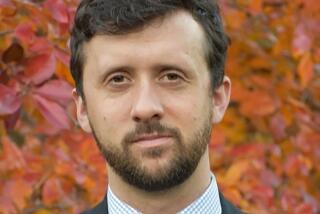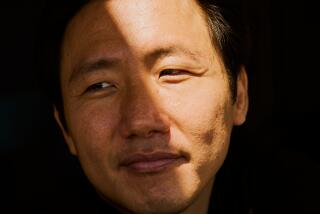007: BONDING FACT AND FICTION
Spies are statements of our national loyalty.
--Spy novelist John le Carre
James Bond has a new face. He’s mean and lethal in the spirit of the early Bond films and original Ian Fleming novels. In “The Living Daylights,” he comes up against international arms merchants, a phony KGB defector and an intricate political money-laundering operation that takes him around the world.
It’s wonderful fantasy . . . or is it?
The plot of the new Bond sounds suspiciously like today’s headlines. It doesn’t take more than a blink and you’d swear that new face belonged to Lt. Col. Oliver North and not Timothy Dalton. For that matter, isn’t that Fawn Hall playing Moneypenny and John Poindexter the redoubtable M? Throw in a $30,000 Porsche--allegedly bought with illicit funds by Gen. Richard Secord--and you have a flash of conspicuous consumerism Fleming/Bond would eagerly applaud.
Now, which scenario is fact and which is fiction?
James Bond is unquestionably a modern icon. Politicians and newscasters invoke his name to illustrate that “some intelligence operation” owes its inspiration to fiction, or that Fleming’s fictions pale beside the documented realities. The paraphernalia of spying--listening devices, special armaments, infrared cameras, etc.--have titles such as Datatek’s Intimus 007S. That’s a paper shredder.
“Bond is what the public wants to believe,” said Richard M. Bissell, former deputy director and chief of clandestine services (the “dirty tricks” department) at the CIA during the Eisenhower and early Kennedy years. From his home in Framington, Conn., he said that he feels “one could argue (President) Kennedy wanted to adopt the style of the novels into the working operations of the agency. That seems quite apparent when you examine operations after the Bay of Pigs.”
“There is a surprising degree of reality in the novels,” said Peter St. John, a professor of political science at the University of Manitoba, Winnipeg. “Fleming was high enough up in intelligence systems during the war to know how they worked, and his writing reflected a keen sense of prevailing Western political sentiments.”
Misha Tsypkin, who emigrated from the Soviet Union a decade ago and now teaches national security affairs at the Naval Post Graduate School in Monterey, said that one has to place Bond in his proper historical context. “He was one of the earliest fictional embodiments of Cold War propaganda. Bond was both the embodiment of ruthless imperialism and class snobbery. If nothing else, the novels and films point to a persistent anti-Soviet culture in the United States.”
The novels were also required reading, according to St. John, on another account: “The Russians believed Fleming’s description of a spy agency to such an extent that the arrival of a Bond alternative, in the form of John le Carre’s spies, created a fierce controversy among their intelligence analysts.” It went so far as accusations that Le Carre, the British author whose celebrated novel “The Spy Who Came in From the Cold” was published in 1963, had been a field operative on a famous covert operation in 1948. The author responded back in the ‘60s, “I was an enterprising spy--aged 16.”
Bond was born January, 1952, at the Imperial typewriter of Ian Fleming, a 43-year-old, one-time British Naval Intelligence officer who was foreign editor at Kemsley Publications, owners of London’s Sunday Express. He had brushes with foreign intrigue dating back to 1933, when he covered a British spy trial in Moscow for Reuters news service and was asked to keep his eyes and ears open for the Secret Service.
During World War II, as assistant to the director of Naval Intelligence, he was an “ideas” man who suggested, among other things, freezing clouds, mooring them along the coast of southern England and using them as platforms for anti-aircraft guns. The concept ultimately was rejected as “unworkable.”
In “The Master Book of Spies” author Donald McCormick wrote: “What is unique to the British Secret Service is a very special and almost unique talent for dreaming up situations and then proceeding to create them in real life.” Fleming was certainly in his element.
As liaison officer between American and British covert operations, the future spy novelist claimed to have advised America’s newly formed Office of Strategic Services on structure and procedure of a spy network. The position also allowed him to nurture friendships with most of the key members in the emerging U.S. intelligence community, including Allen Dulles, Bissell’s boss.
John Pearson, an associate of Fleming’s at Kemsley and the author of “Alias James Bond--The Life of Ian Fleming,” called the author “the ‘Chocolate Sailor.’ He had a driving need to keep his hand in, be part of the game. I doubt that what he was doing was official or significant, but it unquestionably gave his work a real currency.”
Fleming’s political associations--Bissell recalled that Dulles kept in frequent contact with the author--were instrumental in engineering a historic meeting on March 13, 1960. Pearson recalled that at a small dinner party in Washington, Fleming was introduced to Democratic presidential candidate John Kennedy. Fleming’s crowning achievement that evening was a scenario for deflating Fidel Castro, Washington’s latest headache.
“Ridicule” was the author’s advice, as Pearson related the incident. What mattered to Cubans were money, religion and sex. So, he recommended showering Havana with money and leaflets from American planes, creating the illusion of a heavenly cross in the sky for the superstitious population, then dropping additional leaflets (but from Soviet aircraft) stating that U.S. atom-bomb testing had left the atmosphere over the island radioactive and that radioactivity is held longest in beards and leads to male impotence. Fleming reckoned that a shaven nation could not have a revolution.
Fleming’s gift as a raconteur must have been impressive, because the plan was forwarded to the CIA--which ultimately rejected it as operationally infeasible.
Virtually a year to the day later, Kennedy listed “From Russia With Love” as his ninth favorite book. Its inclusion in a Life magazine article on the reading habits of the new President looms like a “circle-what’s-wrong-in-this-picture” game. Topping Kennedy’s 10-best list was a biography of Lord Melbourne. Biographies of Marlborough and Byron were also featured, and the only other nonfiction entry was Stendahl’s “The Red and the Black.”
ABC newsman Pierre Salinger, formerly Kennedy’s press secretary, said from Paris: “I was simply given the list and instructed to distribute it. There’s been speculation its inclusion was engineered to show he wasn’t an egghead. I don’t know if that’s true or not, but I can tell you people were shocked on Capitol Hill.”
The article was a tremendous boon to producers Albert (Cubby) Broccoli and Harry Saltzman, who only months earlier had acquired film rights to the Bond novels. By year’s end, they were in pre-production on “Dr. No” and had a deal with United Artists for a second installment--”From Russia With Love.”
Kennedy had done more than just help popularize the novels and pave the wave for screen adventures. He had “created a public tolerance for this type of activity,” said Roy Godson, a professor of government at Georgetown University. “Kennedy was fascinated by these types of operations. No other President, before or since, has been as actively involved in the covert-action aspect of spying.”
“Kennedy gave the CIA a dash and elan it had not know with the public,” said Jack Valenti, the former aide to Lyndon Johnson who now heads the Motion Picture Assn. of America. “Dulles, Bissell and the others in the intelligence community were Ivy League and urbane. They were perceived as pretty stuffy. Suddenly they became mavericks, loose cannons--real exciting guys. They were our James Bonds.”
It was an ill-fitting garment. Bond, after all, was intrinsically British. Ernest Cuneo, a legal aide to Franklin Roosevelt working with the Office of Strategic Services and a close friend of Fleming’s, referred to the books as “ludicrous depictions of intelligence services.” Pearson supported Cuneo’s assertion and called “Casino Royale”--the first Bond novel--primarily “an experiment in the autobiography of dreams.”
The dream was taken most seriously by the Soviet intelligentsia who perceived a need for their own James Bond, even though the novels and films aren’t available in Iron Curtain countries. Jonathan Sanders, who teaches a course in Soviet film and TV at Columbia University, said: “Iullian Semyonov is the Russian Ian Fleming. His heroes succeed using their brains.”
Prof. Tsypkin characterizes Semyonov’s heroes as more in the Le Carre mold, “coping with the moral aspects of their work. They are a reaction to what’s called the cult of the decadent Western spy. His stories have no gray areas.” A recent Semyonov film, “17 Moments of Spring,” is based on the true case of the apprehension of an American spy. A weekly TV series in the Soviet Union, “Tass Is Authorized to State,” pits the KGB against American agents, usually in stories set in Moscow.
Richard Maibaum, the veteran Hollywood writer who’s collaborated on 13 Bond movies, said that softening Fleming’s view of the Soviets as a bete noire occured with the second Bond film.
“Our attitude on Russia has reflected that of the government. We’re out of the Cold War and into detente--there’s no need to take a harsher line. Also, I think the people at United Artists always felt that someday they’d sell the films to the Russians.”
While the Soviet Union remains a hold-out, recently the People’s Republic of China made inquiries to United Artists about a Bond film, requesting something with a high adventure, low political content.
Fleming’s Bond was a Cold War warrior whose adventures were set against the espionage conflicts of the ‘50s. Today, he is an anachronism, even if his current screen personification has kept abreast of the prevailing political climate. Maibaum insisted that Bond’s ongoing appeal stems from the fact that “he’s a masculine Englishman who can fight like a thug but is also an elegant gentleman.”
In adapting Bond to the screen, the producers moved away from the author’s casting preference of David Niven to what Fleming called “a Glaswegian lorry driver who mangles my character.” Sean Connery became the embodiment of Bond. He was refined and ruthless and possessed something wholly absent from the novels--a wicked sense of humor.
In spite of their early success, Fleming told friends he hoped future Bond films would be told with a “straight face” and a “desperate sense of urgency.”
It never happened. Instead, a tough, cynical Bond became the public’s perception of the character. Series purists who were never quite convinced by Roger Moore will find Timothy Dalton a more virile, realistic 007. Bond is an attitude rather than a physical presence. He does not lead a convincing double life or, as William Colby, head of the CIA during the Nixon Administration, said, “He’s not the description of an ideal spy--a gray man who has a hard time catching the eye of a waiter in a restaurant.” On that basis alone, Oliver North would seem a dubious candidate for field work.
Fleming adhered to the tradition of the “Great Game,” as Kipling called spying in “Kim.” It embraced the British class system, king, country and maintaining the Empire. Cuneo said that as a “second son” (Fleming’s older brother, Peter, was an established writer by 1940), Fleming’s role was to go out and defend and expand the Empire.
That concept is totally foreign to Americans, but just as the author fudged the definitions of spy and counterspy, the movies have muddied the original Bond by allowing him to incorporate the ethos of a tough American private eye and to more vigorously pursue things of a material nature with the help of brutality and technical know-how.
So, if the British are gentlemen and game players, how are American spies categorized?
Infomaniacs?
That’s the conclusion of Gen. Alexander Orlov, the highest-ranking Soviet security official to defect to the West. Orlov, who died in 1975, detailed in his “Handbook of Intelligence and Guerrilla Warfare” the lengths to which American intelligence agencies monitor “open sources.” For instance, daily transcriptions of foreign radio programs could fill 50 books.
Of this arms-length process, he advised: The task of intelligence services is to acquire the keys to where secrets are kept and lay the secrets before their governments and thus provide them with foreknowledge. Important state secrets aren’t found in books and radio broadcasts.
Prof. Godson explained that intelligence services of democracies tend to be “externally oriented. The Soviets are much more involved with internal collection, so ironically we often find ourselves using the same reports for very different purposes.”
“The Soviets break down into two types,” according to Soviet emigre Tsypkin. “There are hunters (the traditional aggressive leadership of Stalin and Brezhnev) and card players (the new wave favoring glasnost ). Gorbachev is a cerebral card player.” He’s also a former KGB officer, reportedly trained by Kim Philby, one of Britain’s most notorious defectors. The latter fact gives frightening credence to contemporary spy fiction that focuses on a fascination and attraction to one’s counterparts on the opposite side.
The line between fact and fiction in the world of spies is precarious, if it exists at all. Screenwriter Maibaum recounted an incident during his research for “The Spy Who Loved Me” to illustrate. “Our villain was able to spot nuclear submarines using a satellite based on the assumption that atomic material within the subs heats the water, leaving a trail. I asked a general at a satellite tracking installation whether the concept had any validity and he gave me a funny face, said ‘that’s close enough’ and abruptly changed the subject.”
Maibaum used the oxymoron “documented fantasy” to describe the Bond films. “I’m convinced if they (the audience) feel it’s not a real story, you’ve lost them.”
Pearson said those who take Bond seriously are “fantasists” and added that it is the operational style of M.I. 6 (British military intelligence). Godson says 007’s greatest impact is on “non-specialists” (the amateurs), and St. John insists that everyone in the intelligence community goes to the films “if only for their marvelous facility as tension reliever.”
In the menagerie of card players, data accountants, stalkers, moles, sleepers and the like, it’s a cheap shot to take aim at James Bond as a fictional interloper.
Just as Kipling inspired generations into the Great Game, can anyone doubt that the current generation of field operatives might have first brushed up against their vocation in a darkened movie house with Sean Connery, Roger Moore or Timothy Dalton? And, if that’s the case, can’t we anticipate a more civilized glasnost than one negotiated by the spawn of Rambo?
More to Read
Sign up for our Book Club newsletter
Get the latest news, events and more from the Los Angeles Times Book Club, and help us get L.A. reading and talking.
You may occasionally receive promotional content from the Los Angeles Times.









